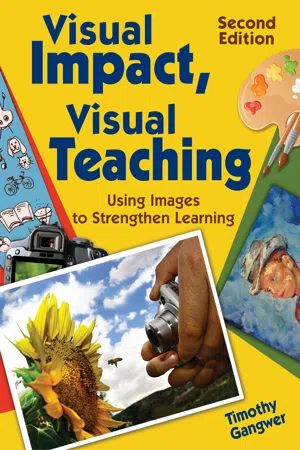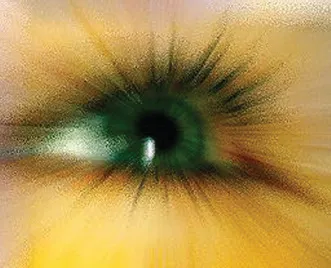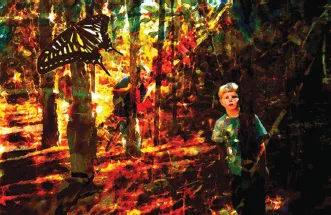
eBook - ePub
Visual Impact, Visual Teaching
Using Images to Strengthen Learning
This is a test
- 240 pages
- English
- ePUB (mobile friendly)
- Available on iOS & Android
eBook - ePub
Book details
Book preview
Table of contents
Citations
About This Book
Offering classroom-tested techniques to engage learners' brains, this book provides ready-to-use visual learning activities in language arts, math, science, social studies, the arts, and more.
Frequently asked questions
At the moment all of our mobile-responsive ePub books are available to download via the app. Most of our PDFs are also available to download and we're working on making the final remaining ones downloadable now. Learn more here.
Both plans give you full access to the library and all of Perlego’s features. The only differences are the price and subscription period: With the annual plan you’ll save around 30% compared to 12 months on the monthly plan.
We are an online textbook subscription service, where you can get access to an entire online library for less than the price of a single book per month. With over 1 million books across 1000+ topics, we’ve got you covered! Learn more here.
Look out for the read-aloud symbol on your next book to see if you can listen to it. The read-aloud tool reads text aloud for you, highlighting the text as it is being read. You can pause it, speed it up and slow it down. Learn more here.
Yes, you can access Visual Impact, Visual Teaching by Timothy Patrick Gangwer in PDF and/or ePUB format, as well as other popular books in Education & Education Teaching Methods. We have over one million books available in our catalogue for you to explore.
Information
1 | What Is Visual Teaching? |
During a rehearsal of Debussy’s La Mer, Maestro Arturo Toscanini found himself unable to describe to the orchestra the effect he hoped to achieve from a particular passage. After a moment’s thought, he took a silk handkerchief from his pocket and tossed it high into the air. The musicians, mesmerized, watched the slow, graceful descent of the silken square. Toscanini smiled with satisfaction as it finally settled on the floor. “There,” he said. “Play it like that” (Fadiman, 1985).

This vignette is a perfect example of why this book is necessary. As a global community, we are in the midst of a paradigm shift. We are moving from a period in which the language of production and manufacturing dominated our way of seeing the world; now, ideas about information and communication shape our discourse. Could it be that we are actually in the midst of an even deeper change—one in which the pendulum of worldview is swinging from a more masculine and word-based culture to one that is more feminine and image based?
It is hard to ignore that the generation of children now moving through our educational system is by far the most visually stimulated generation that system has ever had to teach. Having grown up with cable television, video games, computer software that educates and entertains, and the Internet, our children are truly visual learners coming of age in an increasingly visually oriented world. Notwithstanding individual differences in intelligence and learning style, this generation of children needs to be taught the way they learn best—with visual stimulation accompanied by active learning strategies. As educators, we need to prepare our students for the world in which they will live and work. We must allow this understanding of the visual nature of our students to influence our teaching techniques and the educational technologies we employ. We need to become visual teachers.
INTRODUCTION TO VISUAL TEACHING
Whether you are an early childhood teacher or high school chemistry teacher, visual teaching is a template for all your instructional strategies. Since vision develops rapidly in the infant and so governs human sensory occurrence, it soon evolves into the dominant means through which children learn about their world. Our student population is made up of 65 percent visual learners, 30 percent auditory learners, and 5 percent kinesthetic learners (Mind Tools, 1998). Based on the concept that visual images are a language, visual literacy can be defined as the ability to understand and create visual messages. Development in the area of visual literacy has focused on the growth and expansion of educational programs that stimulate students’ abilities to assess and produce a visual language, as well as enhancement of students’ reading and writing skills through the use of visual literacy strategies.

Visual Literacy refers to a group of vision-competencies a human being can develop by seeing and at the same time having and integrating other sensory experiences. The development of these competencies is fundamental to normal human learning. When developed, they enable a visually literate person to discriminate and interpret the visible actions, objects, symbols, natural or man-made, that he encounters in his environment. Through the creative use of these competencies, he is able to communicate with others. Through the appreciative use of these competencies, he is able to comprehend and enjoy the masterworks of visual communication.
—(John Debes, cofounder of the International Visual Literacy Association, 1969, 27)
Visual literacy in the classroom has become increasingly important as more and more information and entertainment is accessed through technology. Students must maintain the ability to think critically and visually about the images presented to them in today’s society. The Dale Cone of Experience model is based on the concept that learning evolves from the concrete to the abstract; visual symbols are nonverbal representations that precede verbal symbols (Sinatra, 1986). Because pictures or illustrations are analogs of experience and are only one step removed from actual events, these visual representations may be able to capture and communicate the concrete experience in various ways.
To address the effective use of visual skills in the pursuit of learning, visual learning theory has evolved into four key elements: full-spectrum visual learning, active and performance-based learning, dynamic translation, and a multidisciplinary approach.
Although we should attempt to preserve textual notions of literacy, it would be a breach of our duties as teachers for us to ignore the rhetorical power of visual displays. Visual forms of media, by themselves, and in combination with text and sound, come at our students from all directions, including television and the World Wide Web. The critical media literacy we need to teach must include evaluation of these media, lest our students fail to see, understand, and learn to harness the persuasive power of visual media.
—(Michael Day, Chair of the National Council of Teachers of English’s Assembly for Computers in English (Day 1997)
Full-spectrum visual literacy is defined as the ability to understand non-linguistic communication made with visual imagery and the ability to use visual imagery to communicate. Individuals become visually literate by means of the practices of visual encoding (expressing thoughts and ideas in visual form) and visual decoding (translating the content and meaning of visual imagery).
Active and performance-based learning is an active approach to engaging the world. Photography is an ideal medium for experiencing and encountering. People must constantly be challenged to apply knowledge to new and authentic situations as they use the tool of photography to interface with the real world.

Dynamic translation is the process of expressing ideas in new forms. When people take a thought and express it as an image, or object, or text presentation, they understand that thought in a deeper sense. Real learning has occurred when individuals can express ideas not simply in the form in which they were originally delivered, but also in new and varied forms.
The multidisciplinary approach encourages writing and connecting, clustering and creative expression, imaging and visual thinking. This approach also reflects an awareness of the dynamics of various styles and modalities of learning and experience.


Visual skills can be learned. They are not usually isolated from other sensory skills. Teachers should provide appropriate learning environments and materials to allow students to create their own visual messages. Digital literacies such as computers, audiovisual materials, and multimedia, require different skills. Competency in one literacy does not necessarily transfer to another. Because visual arts can impact student emotions and assist in comprehension, teachers should guide students through the process of learning to recognize and respond to visual and print messages of humor, irony, and metaphor. They may also require guidance to distinguish between factual and fictional visual representations. Students’ learning rates increase when teachers support a variety of learning styles. Studies have shown that processing in reading and math involves both phonological and visual information, thereby increasing reading, writing, and mathematical skills through the use of visual literacy (Stix, 1996). In a study conducted with groups of students enrolled in a mathematics methods course (a required course using pictorial journals for those teaching at the elementary level), the groups reported a better sense of task and a more focused introduction to their visual learning journal. Both groups agreed that their math anxiety decreased and their self-confidence increased as a result of the pictorial journal assignments (Stix). If visual literacy is perceived as a language, then there is a need to know how to communicate using this language, which includes being attentive to visual messages and critically reading or viewing images as the language of the messages. Visual literacy, like language literacy, is culturally specific, although there are certainly universal symbols or visual images that are globally understood. “When words and visual elements are closely entwined, we create something new and we augment our communal intelligence … visual language has the potential for increasing ‘human bandwidth’—the capacity to take in, comprehend, and more efficiently synthesize large amounts of new information” (Horn, 2001).
Who Is the Visual Teacher?
The visual teacher is an educator who
- embraces and models full-spectrum visual literacy and
- understands the effects of visual stimulation on brain development and, where appropriate, utilizes imagery to enhance learning.
The visual teacher understands
- the underlying concepts of visual literacy. Imagery communicates in an emotional and prerational style that can bypass logical thought. Imagery invokes the part of our brain that assembles symbols and visual elements into stories.

The visual teacher actively encourages
- students to decode still images, such as documentary or advertising photography; and
- moving images, such as commercials, newscasts, and dramatic or comic television programs and films.
The visual teacher explores
- with students the signs and symbols in art and visual media.
The visual teacher encourages
- students to encode or make more effective still images through an understanding of passive, neutral, and active imagery.
The visual teacher avoids
- passive learning experiences by bridging “seeing” and “doing” through the use of appropriate projects, activities, and technologies.
The visual teacher creates lesson plans and activities that reflect the methods of visual learning, acknowledging that when we create and utilize images we will most likely be working in one (or more) of the following modes:
- Investigate
- Communicate
- Chronicle
- Inspire
- Express
- Envision
The visual teacher responds to student image making, evaluating effectiveness based on criteria that correspond to the methods of visual learning:
- Did you discover something new (external)?
- Did you record your observation faithfully and accurately?
- Did you manifest an idea, thought, or feeling in visual form?
- Would a viewer “get” the idea, thought, or feeling you have expressed in visual form?
- Has your image changed a viewer’s mind or influenced his or her behavior?
- Did you discover something new (internal)?
The visual teacher creates assignments and activities that allow students to develop and apply their visual information handling skills by using the abilities
- to organize images for effective display;
- to establish visual criteria and arrange images in a visual database;
- to substitute images for words and establish a visual language;
- to combine images with text to share ideas more effectively;
- to integrate images with live presentations to communicate more powerfully; and
- to alter, manipulate, or transform existing images to envision something new.
THE SIX METHODS OF VISUAL LEARNING
The visual teaching template is appropriate for all subjects and grade levels. Think of these methods in comparison to a computer. The computer can be used at any level or subject, simply by varying the software. Although the lessons of visual learning may vary, the six methods of visual learning are constant. Although imagery comes in all forms and varying media, a camera is an excellent classroom tool to enhance visual awareness and increase visual learning skills. Students naturally and honestly communicate through the lens of a camera. Their world of nonwritten, non-verbal communication is funneled through a small window. Instant cameras are particularly useful for classroom activities. They provide a tangible, instant product of the students’ success, and images can immediately be integrated into the lesson.
Whether we choose a camera or pen, we are probably going to use that tool to investigate, chronicle, express, communicate, inspire, or envision. Each of these methods, whether we are writing or taking photographs, has its own set of expectations and criteria for evaluation. Understanding these methods will help you think about the types of assignments you give and the best way to understand the results.
1. Investigate
Seeing through the eye of a camera’s viewfinder can often help focus attention and clarify thought. Investigating assignments ask participants to use words and images to learn about and better understand the world. Clustering, listing, visual-thinking maps, and other prewriting activities are examples of explorational methods of communication. Use the camera as a tool to observe, study, identify, and learn. As a tool for investigation, photography helps us focus our attention and concentrate on detail.
2. Chronicle
Chronicling assignments freeze moments in time. Documentary imagery and descriptive writing are examples of working in the chronicle method. We judge images by how honest or accurate they are. As a tool for documentation, imagery helps us record and annotate a rapidly changing world.
3. Express
Expressive works reveal thoughts and feelings and translate the abstract to the concrete. Visual journals and stream-of-consciousness techniques are expressive exercises. Use the camera to create a visual language and relea...
Table of contents
- Cover Page
- Dedication
- Title
- Copyright
- Contents
- Foreword
- Preface
- Acknowledgments
- About the Author
- 1. What Is Visual Teaching?
- 2. Brain-Compatible Learning
- 3. Visual Communication Tools
- 4. Fine Arts
- 5. Visual Communication Skills for English Language Learners
- 6. Subject-Specific Visual Learning Activities for the Classroom
- Conclusion
- References
- Suggested Reading
- Index